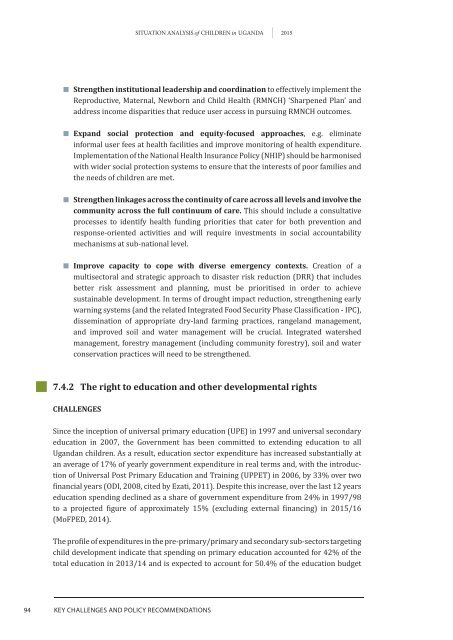Situation analySiS
1TNu802
1TNu802
Create successful ePaper yourself
Turn your PDF publications into a flip-book with our unique Google optimized e-Paper software.
<strong>Situation</strong> <strong>analySiS</strong> of Children in uganda 2015Strengthen institutional leadership and coordination to effectively implement theReproductive, Maternal, Newborn and Child Health (RMNCH) ‘Sharpened Plan’ andaddress income disparities that reduce user access in pursuing RMNCH outcomes.Expand social protection and equity-focused approaches, e.g. eliminateinformal user fees at health facilities and improve monitoring of health expenditure.Implementation of the National Health Insurance Policy (NHIP) should be harmonisedwith wider social protection systems to ensure that the interests of poor families andthe needs of children are met.Strengthen linkages across the continuity of care across all levels and involve thecommunity across the full continuum of care. This should include a consultativeprocesses to identify health funding priorities that cater for both prevention andresponse-oriented activities and will require investments in social accountabilitymechanisms at sub-national level.Improve capacity to cope with diverse emergency contexts. Creation of amultisectoral and strategic approach to disaster risk reduction (DRR) that includesbetter risk assessment and planning, must be prioritised in order to achievesustainable development. In terms of drought impact reduction, strengthening earlywarning systems (and the related Integrated Food Security Phase Classification - IPC),dissemination of appropriate dry-land farming practices, rangeland management,and improved soil and water management will be crucial. Integrated watershedmanagement, forestry management (including community forestry), soil and waterconservation practices will need to be strengthened.7.4.2 The right to education and other developmental rightsCHALLENGESSince the inception of universal primary education (UPE) in 1997 and universal secondaryeducation in 2007, the Government has been committed to extending education to allUgandan children. As a result, education sector expenditure has increased substantially atan average of 17% of yearly government expenditure in real terms and, with the introductionof Universal Post Primary Education and Training (UPPET) in 2006, by 33% over twofinancial years (oDI, 2008, cited by Ezati, 2011). Despite this increase, over the last 12 yearseducation spending declined as a share of government expenditure from 24% in 1997/98to a projected figure of approximately 15% (excluding external financing) in 2015/16(MoFPED, 2014).The profile of expenditures in the pre-primary/primary and secondary sub-sectors targetingchild development indicate that spending on primary education accounted for 42% of thetotal education in 2013/14 and is expected to account for 50.4% of the education budget94 KEy ChaLLENGES aND PoLICy rECoMMENDatIoNS




